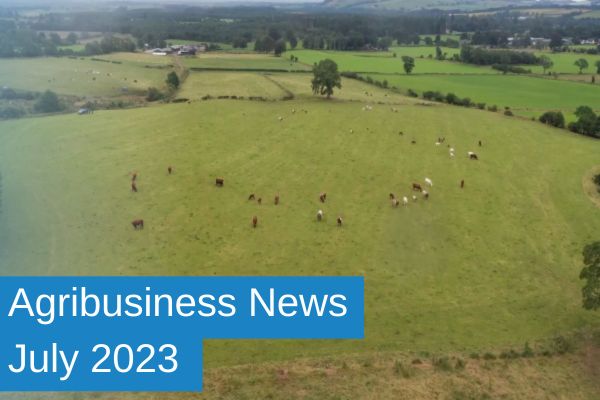Agribusiness News July 2023 – Soil Compaction and Grassland Yield Loss
3 July 2023Understanding the effects
Understanding the effects of soil compaction should be part of a regular assessment of overall soil health for grassland farmers as well as arable farmers. The trampling by livestock and trafficking of grassland fields with heavy machinery has been shown to have effects on yield reductions from compaction that might not be obvious once the sward has started growing.
Soil compaction can restrict the growth of roots,and limit the availability of nutrient uptake, so the fertiliser applied is not used efficiently for grass yield. This can lead to wasting money on costly fertilisers that are not being used and additionally increase the nitrous oxide emission from the sward leading to an increase in greenhouse gas emissions.
Research at SRUC Dairy Research and Innovation Centre at the Crichton Royal Farm in Dumfries over a period of three years has shown an accumulated reduction in grassland dry matter yield of over 14% from machinery trafficked fields and over 11% for cattle trampling. These effects were also seen at a sister experiment based at Harper Adams University in Shropshire on a lighter, sandier soil.
Do I have soil compaction?
The potential for causing soil compaction increases the wetter the soil becomes therefore avoiding compaction initially by not turning out livestock or driving over wet ground, especially after several days of rainfall should be considered. However, if this cannot be avoided then a check on the soil structure should be done to assess any damage. This can be achieved simply with a spade by digging out a block of soil a spade depth (approximately 23cm) and the width and length of the spade (20cm x 20cm). The use of the assessment sheet for the Visual Evaluation of Soil Structure (VESS) developed by SRUC gives descriptions of the status of the soil structures and example photos of the level of compaction (Slide 1 (sruc.ac.uk)). The VESS method has now been adapted by AHDB as part of their soil health monitoring scorecard and is in use in countries such as Switzerland and Brazil. The descriptions are based on a traffic light system with scores of 1 or 2 indicating good soil structure and only to reassess after any further suspected compaction event. A score of 3 indicates some compaction and to think about a change in management, a score of 4 or 5 indicates intervention is needed to improve the soil structure and remove the damage.
Depth of soil compaction
Soil compaction may not only occur at the surface but can have been produced at a lower soil depth, especially if caused by heavy machinery. The VESS assessment also helps in decisions on what method of improving the soil structure is most suitable. This is the idea of the ‘limiting layer’ – what depth in the soil is the compaction that is having the most effect on the grass yield. If the soil is most compacted at the surface (0 to 15cm) then spiking or surface aeration would be the best management of this problem. However, if the compaction layer is deeper in the soil profile (15 to 30cm) then, for grassland, a sward lifter would be most suitable. The tines of the sward lifter, when used, need to be set below the compaction layer or the results can be increased compaction (fas.scot/downloads/technical-note-tn739-use-of-a-sward-lifter-to-improve-grassland-soil-compaction/).
A sward lifter is a useful tool for improving soil structure at depth, however, care must be taken not to drive over areas that have been recently sward lifted as these can ‘slump’ and create a worse soil compaction problem.
Other considerations
Apart from keeping off wet soils as much as possible, there are a number of other considerations to help reduce soil compaction. These include ensuring any water that drains through the soil is allowed to flow away through a functioning drainage system, if one is installed.
The more the load is spread across the surface of the field will help reduce damage, so low-pressure tyres should be considered. It is not always the weight of the tractor that causes the damage but what is being towed. If wet during silage harvest it can the trailer plus the 10 t of cut grass it contains that is compacting the soil, therefore a double axel trailer with wide tyres can also help prevent damage.
Overall, an awareness that compacted grassland soils lead to yield reductions but there are solutions to improving the soil structure that ensures healthy grassland yields are maintained.
Sign up to the FAS newsletter
Receive updates on news, events and publications from Scotland’s Farm Advisory Service

